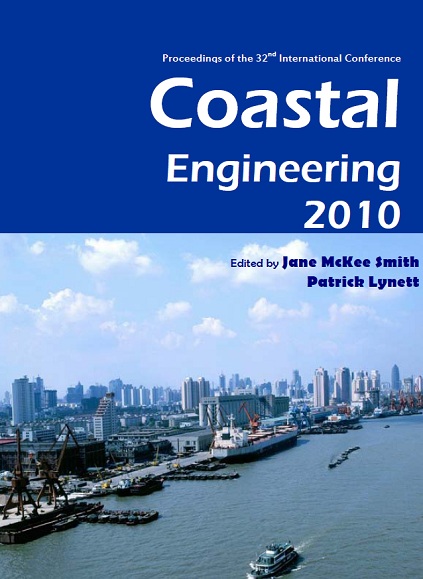Abstract
In this paper the assessment of the preliminary results of a methodology to enable predictions of medium-term morphodynamics accounting for the effects of storms is carried out. The methodology integrates the approaches based on a morphological acceleration factor and on the empirical orthogonal functions to account respectively for the morphological changes on the medium and short term. In a very simplified fashion, the effects of the storms are represented by a superposition of most relevant bathymetrical changes. The effectiveness of the methodology was assessed for a coastal stretch along the German Baltic Sea. The analysis of the simulations of morphodynamics for a period of 10 years showed that the method is able to predict volumetric changes along the coastal stretches reasonably well. However it fails to describe the spatial variation of the morphological changes near the coast. Sensitivity studies show also that the results are significantly affected by the set-up scheme of the methodology. Preliminary results during the assessment of the methodology gave clues about the evolution of the morphology of the German Baltic Sea coast. The methodology can be used as a practical tool for initial assessments of tendencies of morphological evolution. Obviously, in this investigation, the method proposed to account for to the storms is a simplified representation of the reality. In this regard, further research is needed to include a more realistic representation of the chronology taking into account their intensity.References
Anderson, T.R., Frazer, L.N., Fletscher, C.H., 2010. Transient and persistent shoreline change from a storm. Geophys. Res. Lett., 37, L08401, doi:10.1029/2009GL042252. http://dx.doi.org/10.1029/2009GL042252
Boon, J., Kerkamp, H., Dardengo, L., 2002. Alternative dumping sites in the Ems-dollar estuary.
Bruss, G., Jimenez, N., Mayerle, R., 2009. Bestimmung von Bemessungsparametern fur Kustenschutzanlagen and der Deutschen Ostseekuste aufbauend auf Szenariosimulationen. Die Kuste, Heft 75 (in German).
Costas, S., Alejo, I., Vila-Concejo, A., Nombela, M.A., 2005. Persistence of storm-induced morphology on a model low-energy beach: A case study from NW-Iberian Peninsula. Mar. Geol. 224, 43-56. http://dx.doi.org/10.1016/j.margeo.2005.08.003
Dietrich, G. and Weidemann, H., 1952. Stromverhältnisse in der Lubecker Bucht, Die Kuste 1 (in German).
Engelund, F. and Fredsøe, J., 1976. A sediment transport model for straight alluvial channels, Nordic Hydrology, 7, 296-306.
Frazer, L.N., Anderson, T.R., Fletcher, C.H., 2009. Correction to 'Modeling improves estimates of shoreline change', Geophys. Res. Lett., 37, L20401, doi:10.1029/2009GL041993.http://dx.doi.org/10.1029/2009GL041993
Houser, C., Hamilton, S., Meyer-Arendt, K., Oravetz, J., 2007. EOF analysis of barrier island morphological change during Hurricane Ivan. Coastal Sediments, 2007.
Jimenez, N., Bruss, G., Eiben, H., Mayerle, R., 2009. Seegangsmodellierung der Ostsee fur Extremereignisse und Rekonstruktion des Sturmes von 1872, die Kuste, 75, 191-205 (in German).
Kannenberg, E.G., 1952. Das Lubecker Lokal-Schrifttum uber das Brodtener Ufers. Die Kuste 1(2), 12-14 (in German).
Pratje, 1948. Die Bodenbedeckung der sudlichen und mittleren Ostsee und ihre Bedeutung fur die Ausdeutung fossiler Sedimente. Dt. Hydrogr. Z., 1, 45-61 (in German).
Preisendorfer, R.W., 1988. Principal component analysis in meteorology and oceanography, Elsevier. Roelvink, J.A., 2006. Coastal morphodynamic evolution techniques, Coastal Engineering, 53, 277-287.
Schmitz, R., 2007. Vorhersage von historisch aufgetretenen Sturmen uber der Ostsee mithilfe des Ensemble Prediction System und COSMOS (in German).
Schwarzer, K. and Krause, R., 2008. Untersuchung zur Moprh- und Sedimentdynamik im Hinblick auf eine Kustensicherungs- und Hochwasserschutzmaßnahme im Bereich Timmendorf Strand, University of Kiel (in German).
Van Rijn, L.C., Walstra, D.J.R., Grasmeijer, B., Sutherland, J., Pan, S., Sierra, J.P., 2003. The predictibility of cross-shore bed evolution of sandy beaches at the time scale of storms and seasons using process-based profile models, Coast. Eng., 47, 295-327.http://dx.doi.org/10.1016/S0378-3839(02)00120-5
Zhang, K., Douglas, B. C., and Leatherman, S. P., 2002. Do Storms Cause Long-Term Beach Erosion along the U.S. East Barrier Coast? J. Geology 110, 493-502. http://dx.doi.org/10.1086/340633
Zyserman, J.A. and Fredsøe, J., 1994. Data analysis of bed concentration of suspended sediment, Journal of Hydraulic Engineering, ASCE, Vol. 120, No. 9, 1021-1042.http://dx.doi.org/10.1061/(ASCE)0733-9429(1994)120:9(1021)

